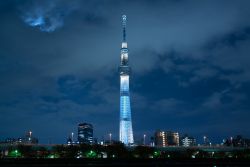
September 4, 2008
Troubled Waters
As typhoon season looms, Tokyo finds that its flood-prevention efforts are all wet
By Metropolis
Originally published on metropolis.co.jp on September 2008

(All images Courtesy of the Ministry of Land, Infrastructure and Transport)
When Hurricane Katrina devastated New Orleans and much of the US Gulf Coast in 2005, a lot of nervous government officials in Japan wondered what it would be like if Tokyo were hit by a typhoon of similar magnitude. It seems that every time there’s a torrential downpour or a few snowflakes in the city, the transport system is thrown into chaos, schools close, and TV networks start posting emergency bulletins. So what would happen to Tokyo and the rest of Kanto in the event of a major flood—and what countermeasures are in place to enable a quick response from the government?
According to the Cabinet Office, which oversees the various ministries and bodies in charge of disaster management, a full half of the country’s population is concentrated in low-lying “inundation areas,” and the basins of 248 major rivers are designated as potential flood hazards. In the Tokyo metropolitan region, those bodies of water include the Sumida, Tama, Tone, Arakawa, Kanda, Ayase, Naka and Daiba rivers. Most of these are relatively steep and have a rapid water flow, thanks to the short distance from the headwaters to the sea. In the Tokyo area, an estimated 116 square kilometers of land lies below sea level, which means it would be inundated should embankments collapse. According to the Cabinet Office, Nerima is the highest ward, while large parts of Kita, Arakawa, Edogawa, Koto, Adachi, Taito and Katsuhika wards would be at most risk during a major flood.
But don’t head for high ground in Nerima just yet. The good news is that, in all its recorded history, Japan has never been hit by a typhoon as strong as Hurricane Katrina. The most destructive storm was Typhoon Kathleen in 1947, which claimed 3,769 lives. Nevertheless, smaller floods have occurred in more than 90 percent of municipalities throughout Japan during the past ten years. A deluge in Tokyo in October 2004, for example, flooded Azabu-Juban subway station, and last September a typhoon stopped JR lines and stranded 1.2 million commuters. The Tama River reached a dangerous level, and some residents near its banks had to be evacuated.
“Experts in the US and Japan have said that a disaster like Katrina only happens once every 400 years,” says Goro Yasuda, counselor for disaster management at the Cabinet Office, which reports directly to the prime minister. “Sadly, in the past, the mindset has been to prepare for disasters based on recent events, rather than on the worst-case scenario. We can no longer take anything for granted. The Ministry of Land, Infrastructure and Transport has been shoring up embankments and simulating the flow of water in the event of a major flood through computer analysis. There’s no doubt that if we had a Katrina—or even another Typhoon Kathleen—there would be massive damage.”

Half of the entire country’s population is concentrated in low-lying “inundation areas”
Yasuda was one of many officials who visited New Orleans in the aftermath of Katrina to meet US officials from FEMA (Federal Emergency Management Agency). “FEMA came in for a lot of criticism for its response to Katrina. But I think their evacuation programs were basically quite good. In Japan, we do not yet have such evacuation programs in place,” he admits.
During the past year, the River Bureau, the Central Disaster Management Council and universities have conducted major studies in an effort to develop a worst-case scenario. The Research Center for Disaster Reduction Systems at Kyoto University released a report last summer on what might happen to the rivers in Tokyo in the event of a major typhoon. “The Arakawa and Sumida rivers are close to each other in many areas. If a levee along the Arakawa river breaks, then the water would flow toward Sumida and reach Ginza within 20 hours. It is possible that Ginza would be under two meters of water, Kasumigaseki below knee level, and Marunouchi under about 30cm of water,” the report warns.
Since many buildings in the metropolitan area use underground generators, they would lose power as soon as the floodwaters hit. Subways would also be affected, the Kyoto University report said. “If the levee near Kitasenju station in Adachi Ward breaks, then the water would flow into the station on the Chiyoda line. It would only take about 2 to 3 hours before the water reaches Otemachi following the subway path.” Making matters worse, the report warns that Tokyo’s sewage system would be overwhelmed, causing outbreaks of disease. Roads would be impassable, and cars, trees, manhole covers and other debris would float throughout various parts of the city.
Meanwhile, the Central Disaster Management Council, which is overseen by the Cabinet Office, released another report last October which predicted that if levees along the Tonegawa broke, 6,000 people would die, 2.32 million others would be displaced, and 694,000 households would be waterlogged due to massive flooding. Economic damage was estimated at ¥34 trillion. The CDMC studied 25 computer-generated scenarios of flooding caused by embankment collapses in different spots along the Arakawa river and high tides in Tokyo Bay.
Takayuki Kishii, a professor at Nihon University and a member of the CDMC research panel, says that most projections have been based on recent storms, instead of rarer but potentially more devastating downpours. He said Japan could learn from flood control efforts in the Netherlands and Britain, both of which have been designed to cope with a calamity of gigantic proportions. “Drainage systems in Japan were constructed on the assumption that strong rainfall in a relatively short period happens rarely. But recently, we’ve seen torrential rain in urban areas more often, sometimes heavily concentrated rainfalls of up to 100mm.”
The Japan Meteorological Agency believes that the Kanto region has been battered by bigger typhoons recently because of a changing ocean climate. While the average temperature of seawater around the world rose by 0.5 degrees Celsius during the last century, the Sea of Japan has risen anywhere from 0.7 to 1.6 degrees. Another disturbing trend is that more typhoons have been reaching the mainland, the agency says.
Although the government has elaborate measures for dealing with the aftermath of earthquakes, it lags behind on typhoons. Massive flooding would present a host of challenges, such as rescuing people from the upper floors of buildings, dealing with waterlogged underground areas, and coping with epidemics and a shortage of drinking water.
Local subway operators insist that they’re up to the task. “We have implemented many measures against flooding based on past experience,” says Koji Yamaguchi, a spokesman for the safety affairs department of Tokyo Metro. “Stop-flood boards and flood-prevention doors have been installed at station entrances, and some entrances were raised at locations where the ground is low.” Furthermore, he says, Tokyo Metro trains all its staff to handle such natural calamities, and drills are carried out on a regular basis. “Each station has a unique manual with pictures and detailed diagrams of where equipment is located.”

If levees along the Tonegawa broke, 6,000 people would die, 2.32 million others would be displaced, and 694,000 households would be waterlogged
Overall, the biggest challenge in a disaster is coordination of response efforts, says Yasuda of the Cabinet Office. “The fire departments in each area are in charge of rescue and recovery. Local governments have their own flood defense teams. They conduct drills once a year or more often… Many local governments have also created hazard maps in order to tell local residents about the danger of floods, such as depth of water projected—in other words, whether or not their house will end up underwater. However, the Ministry of Land, Infrastructure, Transport and Tourism has to take charge much more efficiently than it has done.”
One factor that remains alarming is the state of embankments and levees along Japan’s rivers. “Some embankments were built back in the Edo period. We are gradually reinforcing them to make them higher, but it’s not so easy,” says Yasuda. “For example, if there are already buildings near a river, we cannot construct new embankments. So we have a joint project with developers when these buildings are rebuilt, creating new space for so-called ‘super embankments’ with gradual slopes.”
Experts say the Arakawa River needs urgent attention—according to a survey conducted by the ministry last year, as many as 58 percent of the levees along the river aren’t up to the necessary safety level. On the plus side, huge underground discharging channels have been completed at various points beneath the Edo and Tone rivers. As for Tokyo Bay, Kishii of Nihon University says embankments between canals and land are being constructed. “They’re not complete yet, and I’d have to say construction is not going smoothly.”
To boost its readiness, the government monitors rainfall and water levels in rivers via a wireless telemetry system and water immersion sensors that automatically transmit data from remote locations. The government has also recently started measuring rainfall accumulation in soil as a means of predicting landslides. The Flood Control Act, amended two years ago, requires municipal governments to make sure residents are familiar with hazard maps, disseminate disaster information and quickly implement evacuation procedures.
Which is all easier said than done. “One of the biggest problems we face now is apathy among the Japanese population,” Yasuda says. “After Katrina, 80 percent of flood victims in New Orleans were evacuated. When we surveyed people in low-lying areas of Japan, only 46 percent said they would evacuate. Many people, especially those under 50, live in urban areas and have never experienced a large-scale disaster. They are not concerned about flooding.”
The government is trying to jolt citizens out of their complacency. “If only 46 percent are prepared to go in advance of a flood, then several thousands of people are going to die or be cut off. And if they are elderly or children, then their chances are not good,” Yasuda says. “When the Central Disaster Management Council released its report last October, that was the first time it had ever forecast the number of deaths from floods instead of just saying that damages would be in the trillions of yen, as it normally does. We wanted to grab people’s attention. You should never underestimate the power of floodwaters. The damage is not just monetary.”
Chris Betros is the editor of Japan Today www.japantoday.com).





